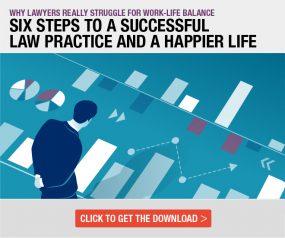If you’re on the fence about being a solo practitioner, these tips from estate planning lawyer Bob Theofanis may inspire you to take the leap and start your own legal practice.

Table of contents
Last year was a year of major change for me. In addition to adding a second child to our family in March, I launched my estate planning practice as a solo practitioner in July. As the year drew to a close, I reflected on what I had accomplished, what I was proud of, and what I could have done better.
Now, with 2020 underway, I’m sharing my top six lessons from my first six months in practice. If you’re on the fence about whether to start your own practice, may they inspire you to make the leap! It’s the best career decision I’ve made.
Lesson No. 1
Do as much as you can ethically while you still have a paycheck.
I left my job before making any preparations for my new law firm as a solo practitioner. This meant I had to quickly set up my legal services to start attracting clients. So, in the first few months, I spent a significant amount of time setting up my website, writing website copy (nearly 10,000 words), incorporating my practice, buying malpractice insurance, and dealing with technology issues.
These foundational tasks are important and must be done. But why wait until your salary’s gone to do them?
If I had a do-over, I would have used my evenings and weekends while I still had a job taking care of these. If you’re worried about privacy, many of the tasks can be done anonymously or in obscurity. (Make sure you’re aware of and follow all ethics rules and requirements during this time.)
Laying the foundation before you leave your job also creates a nice incentive: When you finish, you can quit your job and get going on the new practice!
Lesson No. 2
Stay lean.
Imagining my new practice as a solo practitioner was pure joy and excitement. The possibilities were endless, and I was the boss, ready to practice law on my own terms. I have pages and pages of notes detailing all the technology services I planned on using. (Shiny Object Syndrome? Guilty as charged.)
Thank goodness I didn’t end up buying it all!
Not only would have it been too expensive, but it also would have been counterproductive. Even for a tech-savvy lawyer, setting up a new technology product correctly and learning how to use it effectively takes up valuable time.
Lee Rosen of the Rosen Institute argues that marketing should be your first priority. And, obviously, the client work needs to get done.
My advice for those just starting is to skip the bells and whistles and operate as a “minimum viable law firm.” For example, if you’re a litigator, all you really need to get going is a laptop, a workspace, word processing, PDF-creation software, a legal research resource, a website, and email. Unless a technology product is truly indispensable, hold off.
Related: “How Much Does It Cost to Start a Law Firm?”
Lesson No. 3
Keep taking shots, but learn from the misses.
Have you ever watched a pro basketball player miss 10 shots in a row and then, without hesitation, take the 11th? When the ball is in his hands, he isn’t worried about those misses. You need to adopt that mindset.
My first few marketing events were total flops. Barely anyone showed up and none of the attendees turned into clients. Was it disappointing? Of course. But I couldn’t stop. If I did, my practice as a sole practitioner would die.
Every failure is a lesson in what doesn’t work. With the right mindset, you’ll keep pushing forward. Eventually, all those lessons will guide you to what works.
Lesson No. 4
Plan first, then execute.
Obvious advice, right? But I sure had a tough time following it. I had so many balls up in the air — client work, marketing, finance, technology, website, and on and on — that knowing what to work on was a challenge.
This system is particularly beneficial for sole practitioners who need to manage their finances carefully to ensure long-term sustainability.
For me, it came down to the difference between having a generic plan and a detailed, specific plan.
When I started, my marketing plan was, basically, “get more clients.” But that’s a goal, not a plan. I spent months bouncing around from one idea to the next. For example, I’d invest half a week writing lead magnets for an AdWords campaign only to run Facebook ads for a free webinar the next week. And I never got back to the AdWords project. I wasn’t getting new clients. I was wasting my time. Not good for a solo practitioner.
That’s where planning comes in. It took me nearly six months to finalize my vision and my marketing plan and actually write it down. Both are quite detailed and they contain short-term objective measures of success.
Armed with these, I’ve stopped wasting my time and it is much easier to focus. Now, every task I undertake (including this post) fits within a larger picture. There’s no more chasing the flavor of the month and no more getting sidetracked by other opportunities.
Lesson No. 5
Pay yourself first.
“Profit First” by Mike Michalowicz describes a cash management system for small businesses. Michalowicz’s major insight is small business owners cannot effectively internalize the information presented in traditional accounting reports. Consequently, they resort to “bank-balance” financial management. In other words, “If there’s cash in the account, then I can afford it.”
His system is based on two principles: First, small business owners are entitled to a reasonable profit for their investment of time and capital. Second, a small business owner is also entitled to a reasonable salary for the time they spend working as the business’s most important employee.
The “Profit First” system advocates using five bank accounts to shuffle money around for various purposes. You can think of it as an analog to the envelope-based personal-finance-budgeting system.
While I decided not to follow the book’s guidelines to a tee, I am being strict about paying myself first. I started my practice so I could earn a living on my terms. So, I take 50% of the revenue as a salary as soon as it comes in. As my law firm’s only employee, I deserve a salary for the work I do. If I don’t take it right away, it’s likely to go out the door to someone else.
I take the next 25% and put it in a tax withholding account so there’s something available when April rolls around. I love the security of having a pot of cash for this purpose. Facing down a big tax bill without cash in the bank is super stressful.
The remaining 25% stays in the firm operating account to cover expenses. What if expenses exceed 25%? Well, that’s the beauty of “Profit First.” It’s my job to make sure they don’t. If something doesn’t fit within the 25% budget, then I can’t afford it.
Lesson No. 6
Go after the low-hanging marketing fruit.
I would love to have a highly sophisticated Facebook ad campaign that used targeting to capture email addresses from my ideal clients, funneled them into an email drip campaign designed to sign them up for a webinar, and then led them to sign up for an initial consultation. But that’s the holy grail for a solo lawyer. It isn’t realistic, given my current resources, to spend the time or money on that now as a solo practitioner.
Don’t go hunting for marketing big game. You’ll run out of money before you discover the winning combination. Instead, focus on the low-hanging fruit, which is easier to get right and is often free or low cost.
- Start with a “brochure website” rather than an SEO-optimized, content-rich one. My firm’s site may be bare-bones, but it works.
- Set up your Google My Business profile and ask your clients for reviews. (In fact, ask anyone you come across in a professional setting for reviews.)
- Spend an hour putting some shine on your LinkedIn profile. Make sure your headline clearly communicates your practice area and post a few interesting items a week. Look at other people’s profiles; they’ll see you did and look at yours. That’s branding for you.
- Send hard-copy letters to everyone you know announcing your new practice and asking for referrals.
- Get out of the office. Ask your law school classmates and other lawyers you know to lunch or coffee; make sure you tell them exactly who your ideal client is.
I hope you enjoyed my six lessons. If so, please share this post using the social share buttons below.
Establishing a Solo Law Firm: Great Advice from the Editors
Laying the Foundation for Success
Starting a solo law firm is like building a house—you need a solid base to be stable and successful for the long haul. As a solo you’re not just practicing law, you’re running a business. That means you’re responsible for everything from client management to marketing and financials.
First step is to define your mission, vision and values. What does your law practice stand for? What kind of clients do you want to work with? Answering these questions will help you create a business plan that outlines your goals, strategies and financials.
A business plan is your roadmap. It will help you identify your target market, develop a marketing strategy and create a budget that matches your financial goals. For example when starting a solo practice spend a lot of time researching your target market and understanding their needs. That research can inform your marketing strategy and helped you allocate a budget.
A strong online presence is non-negotiable. A professional website and active social media profiles will attract new clients and promote your services. Made sure your website is up and running before you leave a previous job to get a head start in attracting clients.
Don’t forget the administrative and operational aspects of running a law firm. Managing support staff, financials and compliance with regulatory requirements are all part of the job. By building the base you set yourself up for success and a thriving solo law firm.
Choosing a Practice Area and Marketing Strategy
Aligning Passion with Market Needs
Choosing the right practice area and marketing strategy is key for any solo. It’s not just what you love to do; it’s also what the market needs. When deciding on a practice area do extensive market research and analyzed industry trends to find opportunities and challenges.
Focusing on a niche area of law will set you apart from other lawyers and attract high paying clients. For example a focus on estate planning if you see a growing demand and genuinely want to help families secure their future. This focus can help you differentiate your solo law firm and attract clients who need your expertise.
Once you’ve chosen your practice area you need to develop a marketing strategy to match. A strong online presence is a good start but don’t stop there. Networking with other lawyers and professionals will open doors to new opportunities. Made sure to attend industry events and join professional organizations which can help you build connections.
Targeted marketing like social media advertising and content marketing can also work. Sharing informative blog posts and engaging with an audience on social media can help build credibility and attract clients. By aligning your passion with market needs and developing a marketing strategy you can build a successful solo law firm.
Building a Support Network and Seeking Mentorship
Leveraging Relationships for Growth
One of the biggest challenges of being a solo is the lack of built in support that comes with larger law firms. But you can still build a strong support network by using relationships with other lawyers, professionals and mentors.
Joining professional organizations like the American Bar Association will give you access to networking opportunities, educational resources and mentorship programs. Attending ABA events and participating in their programs can help you connect with experienced lawyers who offered valuable advice and support.
Mentorship is another key step. Experienced lawyers can guide you and help you navigate the complexities of solo practice. If you’re lucky to find a mentor who had been through the same journey and could offer practical advice based on real life experiences, all the better.
Other professionals like accountants, financial advisors and business owners can also be useful. These connections can help you find new opportunities and challenges in your practice area. For example working with a financial advisor might be able to offer more comprehensive estate planning services to your clients.
By building a support network and finding mentorship you can overcome the challenges of solo practice and build a successful and sustainable law firm. Remember you don’t have to go it alone – using relationships will give you the support and resources you need to grow your practice.
Image © iStockPhoto.com.

Sign up for Attorney at Work’s daily practice tips newsletter here and subscribe to our podcast, Attorney at Work Today.
Illustration ©iStockPhoto.com
More Tips on Starting a New Law Practice:
- “10 Rules for Surviving as a Solo or Small Firm Practice” by Dustin Cole
- “Starting Your Dream Business: Three Essentials for $300” by Andrea Cannavina
- “How Much Does It Really Cost to Start a Law Firm?” (eBook)
- “Five Win-Win Ethics Tips for Solos and Startups” by Joan Feldman
- “7 Tips for Making the Move from BigLaw to Solo” by Josh King
Why Do Lawyers Really Struggle for Work-Life Balance?
Successful lawyers adapt and learn new ways to operate their firms so they can keep building their practices while having (or recovering) a life. The six steps in Dustin Cole’s guide, below, will help you lay a foundation of great business practices so you can stop struggling over revenue as the stress continues to mount, and instead prosper both professionally and personally.
Download the free “Six Steps” guide today and get going.
Subscribe to Attorney at Work
Get really good ideas every day for your law practice: Subscribe to the Daily Dispatch (it’s free). Follow us on Twitter @attnyatwork.

















